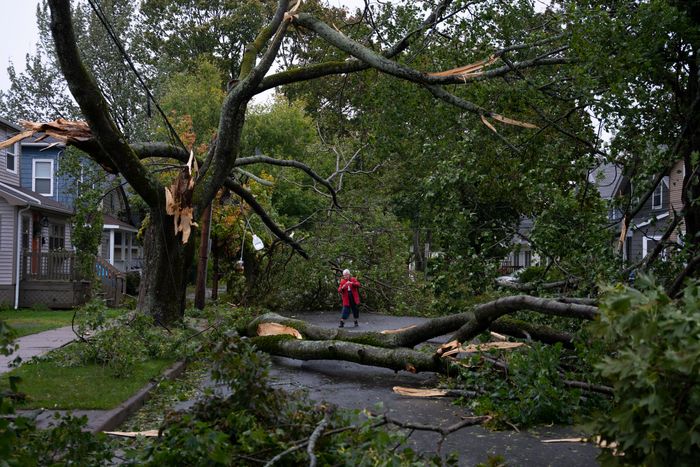Fiona, no longer a hurricane but still a mighty storm, left a trail of devastation across eastern Canada on Saturday as it knocked down power lines, uprooted trees and flooded roads.
Roughly half a million people in Atlantic Canada were without electricity as Fiona raged across Nova Scotia, Prince Edward Island and Newfoundland and Labrador.
Hundreds were displaced in some communities as floods surged over roads and severe winds damaged homes while knocking out cellphone service, complicating the efforts of some first responders to help residents evacuate.
In Halifax, Nova Scotia, more than 100 residents of an apartment complex had to be transferred to a shelter after the building’s roof collapsed.
Cape Breton, a coastal community in the province, was one of the hardest hit, local officials said at an afternoon press conference.
Over 150 people in that area sought shelter during the storm, which made landfall around 3 a.m. local time and then moved over Cape Breton, according to the Canadian Hurricane Centre.
Fiona’s winds, which had topped 80 miles an hour in some places, were still gusting at nearly 60 mph by midafternoon in Nova Scotia, said Bob Robichaud, a meteorologist with the Canadian Hurricane Centre. Rainfall ranged from four to six inches in most of the province, he said.
Conditions were expected to improve throughout the day as rain and winds gradually died down, he said. Officials had gotten reports of floods and expected to get more as cellphone and power services are restored, according to Mr. Robichaud.
Peter Gregg, chief executive of Nova Scotia Power, said his crews had been able to restore service to roughly 60,000 people across the province. But some 380,000 remained without electricity and it might take several days before everyone is reconnected, he said.
On Prince Edward Island, more than 82,000 people were without power overnight and into Saturday.
Charlottetown resident Darlene Eldershaw, 62 years old, said Fiona’s winds began howling around midnight. Roughly two hours later, a tree crashed through the roof of her bungalow, piercing the attic and splitting apart her living room ceiling.
“I’ve lived here my entire life. We have never seen a storm this strong,” said Mrs. Eldershaw, who was evacuated to a shelter and then a hotel along with her husband.
Officials in Port aux Basques, a town at the southwestern tip of Newfoundland, declared a state of emergency as Fiona’s winds clashed with high tides, sending waves crashing into coastal homes and washing out roads.

A resident surveyed the damage wrought by Fiona in Halifax, Nova Scotia, on Saturday.
Photo: Associated Press
One woman whose home was in proximity to the beach was swept into the surf as her house collapsed, said Corporal Jolene Garland, media relations officer for the Royal Canadian Mounted Police in Newfoundland and Labrador.
Neighbors were able to pull her out of the water and she was treated for minor injuries at a local hospital, she said.
Witnesses also reported a second house collapse in a separate incident and said a woman there might also have been swept away, according to Cpl. Garland. But police have been unable to get to the area to confirm the report due to the dangerous conditions, she said.
“There’s winds and rain and flooding, electrical fires in homes, roads washed out,” she said. “With high tide returning…it’s just unfortunately not safe to attend that particular area to commence any kind of search.”
Fiona’s track will continue over the province of Newfoundland and Labrador overnight, said David Neil, a meteorologist based in the region.
“We’re still looking at some pretty stiff winds for much of the island,” he said. “And with an evening high tide, some of those areas that have seen high water levels are going to get a second round.”
Many local officials said they have requested military and financial assistance from the Canadian government. Nova Scotia Power said it has asked for extra line crews from neighboring areas, including Maine.
Rum Runners sweets shop in Halifax closed before the arrival of Fiona.
Photo: INGRID BULMER/REUTERS
In Ottawa, Canadian Prime Minister Justin Trudeau told reporters he agreed to send the military to Nova Scotia to help local authorities with cleanup efforts, and is prepared to assist other Atlantic Coast provinces.
Mr. Trudeau canceled plans to travel to Japan to attend the state funeral of that country’s former prime minister, Shinzo Abe, in order to oversee the government’s response to the storm.
“We are going to be there to help these people,” he said.
The Atlantic hurricane season started off slow this year but has intensified this month. North America was set to see another hurricane in the coming days: Tropical Storm Ian, which forecasters said could hit Cuba early Tuesday as a hurricane and then hit southern Florida in the middle of next week.
Fiona has been churning up the Atlantic since Sunday, when it made landfall in Puerto Rico. The storm was upgraded Wednesday to Category 4, the second-highest hurricane designation, then downgraded late Friday into a post-tropical storm.
Fiona has been blamed for the deaths of at least seven people—four in Puerto Rico, two in the Dominican Republic and one in Guadeloupe.
—Paul Vieira contributed to this article.
Write to Ginger Adams Otis at Ginger.AdamsOtis@wsj.com
Copyright ©2022 Dow Jones & Company, Inc. All Rights Reserved. 87990cbe856818d5eddac44c7b1cdeb8
